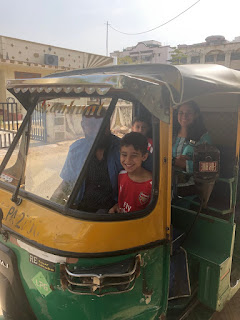New Mission you are ALWAYS on my Mind!

Even though
I am half around the world, I have always had New Mission at the forefront of
my mind when I have been observing classrooms and schools in India. There is so
much that I want to bring back to my school. There are two that stand out the
most. They are:
- Design Thinking Process—I have watched the
Indus International School implement the design thinking process in the 2nd
grade and 8th grade and I piloted with my mentor some mini-DTPs
at the 8th and 11th grade. It was truly incredible
to see the students lite up when the mini-DTP was introduced and how they
discussed their projects. This got me thinking about New Mission.
For years
we have struggled to really build a portfolio process that is meaningful for
the presenter, the parents, and the advisor. We started using Habits of Mind
(Perspective - Considering multiple
perspectives/viewpoints, Evidence - Weighing evidence, Relevance
- Finding value both personally and socially, Reflection -
Rethinking, self-assessing, & self-adjusting for improvement, Connection
- Seeing and making connections and relationships, Supposition -
Imagining possibilities), Essential
Skills (Collaboration and Community Building Skills, Discussion Skills, Organizational
and Study Skills, Presentation Skills Quantitative Skills, Questioning and
Exploration Skills, Reading Comprehension Skills
Research Skills Writing and Revision Skills), and Commitment
to Learning (Student is consistently prepared for class, Student
participates regularly, Student thoughtfully completes homework, Student honors
deadlines, Student seeks extra help in a timely manner OR seeks additional
challenge, Student revises work, Student makes sincere effort to improve.)
Students would need to use all 3 of these elements to talk about how they
contributed to their learning and what they needed to work on. This all sounds
very good, but the presentations were lacking authenticity and were more rote.
They were using the words but not really knowing what they meant and how to
really reflect on their learning in their core content.
Now, through the Design Thinking Process our portfolio
reviews can be revived and have more meaning to their presentations. The
process seems doable for all classes and creates a student centered project
based atmosphere. The following will be evident with students using the Design
Thinking Process:
Design
Thinking Process (DTP)-21st Century Skills Acquired
|
Leadership
|
Meeting
Facilitation
|
|
Critical
Thinking
|
Conflict
Resolution
|
|
Writing
|
Teamwork/Collaboration
|
|
Public
Speaking
|
Research
Methods
|
|
Decision
Making
|
Communication
|
|
Advocacy
|
Time
Management
|
|
Problem
Solving
|
Empathy/Human-Centered
|
|
Creative
Thinking
|
Listening
|
Design
Thinking Process (DTP)-Outcomes for Students-Practical Skills
|
Increased
Social Networks
|
Community
Awareness
|
|
Improved
Self Respect
|
Trusted
and Respectful Relationships with adults
|
|
Enhanced
Self Efficacy
|
Empowered
to Affect Change in Community
|
|
Increased
Self Confidence
|
Awareness
of Social Factors Shaping their Lives
|
|
Instilled
Sense of Civic Responsibility
|
Increased
Self-esteem
|
As a parent and as a teacher, I would want to see these
kinds of presentations. It really brings the learning to life. When I saw my 8
year old son leading a discussion on design thinking, I was sold hook, line,
and sinker. Now, my goal is to try to help my colleagues and administrators
gain the same enthusiasm for the Design Thinking Process.
1. Mindfulness- As New Mission has
taken on a middle school (7th and 8th grade) there has
been a greater need to think about the social and emotional needs of students.
Here in India, I have learned the true meaning of mindfulness and one way to
teach it to kids. The school my kids attend teach students about this phrase Tikkun Olam. Tikkum Olam is a concept in
Judaism that is an aspiration to behave and act constructively and
beneficially. Each child learns about the world and the 17 sustainable
development goals put out by the United Nations. (Of course it is taught
differently at each grade level). Then each child creates their own Tikkun Olam
and it is talked about in school and how they will act on their own Tikkun
Olam. For example, Ashram’s Tikkun Olam is to re-use plastic or other
materials. He has learned how bad plastic is for the environment and comes home
every day to see if we have any plastic that he can re-use and make into a toy.
He has made boats out of plastic water bottles and little flowering pots.
Additionally, one day I was reading the newspaper and he saw an elephant
playing with a tire and he asked about the picture. I told him that it was
artists in Boston re-using tires and made them into toys for the elephants at
the zoo. Ashram said so matter of factly “Oh that is my Tikkun Olam.” If a 6
year old can be that mindful, then we can do it for our students at New
Mission. It truly is a wonderful thing to see my very own kids talk about what
they have learned in school in a very practical way rather than me asking them
what they learned in school. It just becomes a natural discussion. Now that is
truly being MINDFUL! To me, to be mindful is to consciously think about
yourself in the present moment and the impact you have on others and the world
around you.






Comments
Post a Comment